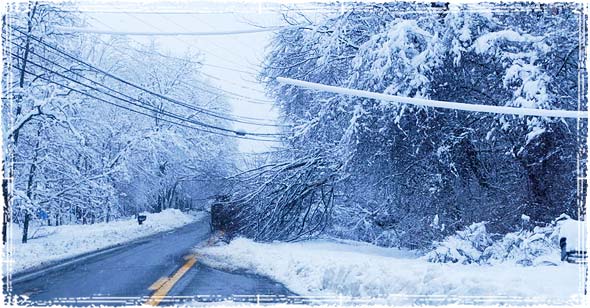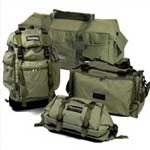Weather can change in an instant; making weather related emergencies something everyone should be prepared for.

When the thermometer starts to dip, you really need to think about winterizing your gear. That means breaking out your bug out bags, opening up those long forgotten vehicle kits, and reevaluating your emergency plans for the season.
If you follow this site, you know that we recommend rotating and inspecting your stocks every 3-6 months. Doing so will help you make sure you have the correct gear for your environment, and the conditions that you’ll be facing this season.
Inspecting and Preparing your Winter Clothing
During the winter months, the clothing you pack in your emergency Go Bags is going to be significantly different from what you carry during the summer. While this hopefully sounds like common sense, there’s a good number of people who have a pack it, and forget approach to preparedness.
If the last time you looked at your emergency bag was more than 3 months ago, chances are the gear, especially the clothing in your bag, is probably not adequate for the coming winter months.
Rotating You Food & Water Supplies
I hope that you’ve taken our advice about rotating your emergency food supplies; if you haven’t, now’s the time to use any emergency food that’s been sitting around, and replace it with a fresh supplies. You also want to washout and refill any emergency water containers that have been sitting for longer than six months.
Gear Checks:
Hopefully you use most of your gear on a regular basis; if you don’t, you might want to think about the importance of training, and learning how to use the gear before an emergency hits.
 If you have a bunch of gear that’s been sitting on the shelf, or left sitting in some long forgotten bug out bag, then you really need to perform some gear checks.
If you have a bunch of gear that’s been sitting on the shelf, or left sitting in some long forgotten bug out bag, then you really need to perform some gear checks.
- Check Everything: It may seem like overkill, but now is a good time to completely unpack and check every piece of gear in your bag. Not only should you be scanning the gear for signs of wear and tear, but you should also be determining if the gear’s right for the coming season.
- Battery Checks: From flashlights and portable radios, to communication equipment and electronic survival gear, now’s the time to test, and if necessary replace the batteries that have been sitting in your equipment. Not only can a dead battery be a major vulnerability in a survival situation, but old batteries can degrade and leak corrosive battery acid into your electronic equipment.
- Knives & Guns: From Sharpening knives to cleaning and oiling your guns, maintenance is a critical factor in maintaining this type of gear. This is something that should be done on a regular basis.
Vehicle Gear Bags & Maintenance
Having an emergency vehicle kit is an important part of being prepared; making sure it’s appropriate for the conditions you’ll face this winter, is absolutely essential.
 Are you up-to-date on your vehicle maintenance? There’s never a good time to breakdown; that’s especially true in the winter. Breaking down during a winter storm is not only inconvenient, it could also be deadly. Make sure you’re up-to-date on your vehicle maintenance. Check your oil, fluids, air pressure, and your spare tires.
Are you up-to-date on your vehicle maintenance? There’s never a good time to breakdown; that’s especially true in the winter. Breaking down during a winter storm is not only inconvenient, it could also be deadly. Make sure you’re up-to-date on your vehicle maintenance. Check your oil, fluids, air pressure, and your spare tires.- Battery Check: I put this as a separate line item, because of how important this can be during the cold winter months. Extreme cold conditions can significantly affect the performance of an automobile’s battery.
- Vehicle Kits: Just like the Bug out Bag inspection that I mentioned above, your vehicle kits should be unpacked and inspected for signs of deterioration. You should also swap out and replace your summer gear with winter gear (sleeping bags, winter clothing, hats, gloves, etc…)
With winter time right around the corner, now’s the time to inspect and winterize your gear.



This year surviving will be a lot harder I think.
Thank-you for this great reminder.
Did you unroll or take out all clothing to make sure you still fit and it was in good working order?
I allways keep my bag next to a closet with winter clothing in it to increase bag space. Think about it, a large winter coat takes up a LOT of a medium alice pack
I always keep spare clothing in my Truck, Everything from a pair of coveralls to work on it and spare underwear and T-shirt, I have needed the underwear before. I keep gloves, silk weight long johns and a beenie. I do need to get a good roadside kit though.
Don’t forget a pair of sturdy shoes
How do you keep drinking water or toothpaste or whatever from freezing?
I don’t store water in the car, wouldn’t last long before it freezes however you can mix it with a sports drink powder which lowers the freezing point quite a bit. I also carry a battery operated UV water purifier as it beats water filters (they crack when they freeze), chemical treatment takes much longer in the cold weather. Melting snow doesn’t produce much water and consumes a lot of fuel if traveling with a small stove.
Skype has launched its web-centered consumer beta to the entire world,
after launching it largely from the United states and U.K.
previously this four weeks. Skype for Internet also now supports Linux and Chromebook for immediate messaging
interaction (no voice and video but, all those need a connect-in set up).
The expansion in the beta contributes help for
an extended selection of spoken languages to help strengthen that global functionality